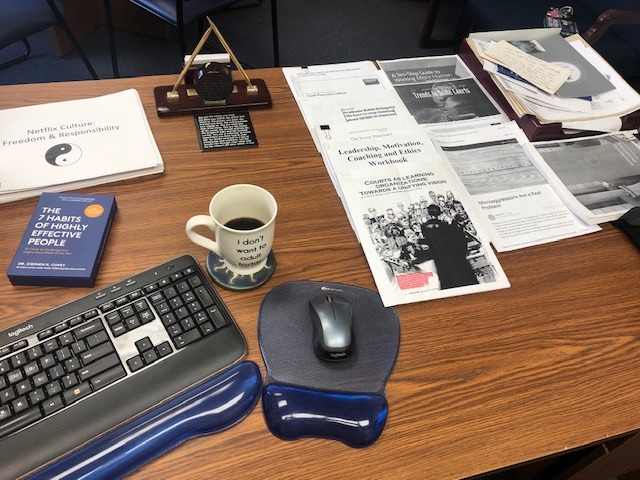Creating a Unified Vision
By NASJE President Janice Calvi-Ruimerman

My space is not my own. Articles that speak to me are kept close to remind me of my vision and my professional focus. My desk, seemingly large, has become ever so crowded by these professional reminders of what, I feel, are important or timely. On the plus side, these items prompt me daily to stay the course. In 2009, I came across an article about education and visioning for the future of the Courts; this has been my Codex ever since. As so pointedly stated in the article, Courts as a Learning Organization: Towards a Unifying Vision, “A learning organization is intended to be a catalyst for continual change.” That became my vision, my proposed unified vision.

In 2015, Connecticut began its journey through the second phase of our Strategic Plan, focusing on our “greatest assets”: our colleagues. With this opportunity came the hope for the continued development of a true learning organization. Turning to the highlighted, worn, tattered article, I asked myself, what will sustain us for the future and unify our vision for ourselves and the Court overall? It’s a unified vision for a true learning organization.
In 2009, Pat Murrell, Gary Schneider and Philip Gould knew that based on the Fifth Discipline by Peter Senge, “a learning organization is one that is continually expanding its capacity to create its future.: Additionally, the National Center for State Courts’ Institute for Court Management defined a learning organization as an “organization in which individuals continually expand their capacity, where people learn to learn together, where knowledge is managed and shared, where innovative and expanded patterns of thinking are nurtured, where collective aspiration is valued, where everyone participates in the organization’s continued evolution.” This is what I want for us all.
According to Murrell, Schneider and Gould, “building a shared vision, striving for commonality of purpose that fosters initiative and community, and team learning to generate communal development, are among the core elements of a learning organization.” I know that we all have been crippled by budgetary constraints, staff reduction due to attrition, retirements and “hard hiring freezes.” I also know that each of us has been asked to “do more and more with less” but expected to deliver the same quality of services as in times when we were fully staffed. It is, however, also true that we can learn to “work smarter, not harder,” and be more resourceful with what we have – the key is education. In order for us to do this we, according to Peter Senge, must commit to becoming a learning organization. As such, we will have to commit to “continually expand [our] capacity to create [our] future.” The axiom “knowledge is power” applies directly to every job in the functionality of the Court as an organization. According to NACM’s Educational Development competency, “a key function for the court leader is the assurance of excellent court performance by actively leading judicial branch education in their courts.” Therefore, identifying untapped potential, maximizing our resources, and creating new ways to do something better, more efficiently and effectively, while getting the “best” out of our colleagues is contingent upon fully educating our employees, colleagues, and the Bench. We, as educators, often become entrenched in our daily “to do’s” and forget our pivotal role in building our learning organizations. Remembering my pivotal role in creating a learning organization is my way of keeping an eye on the prize, so to speak.
In this critical time, we have the unique opportunity to establish our organizations as learning organizations. Our competency rests in our leadership’s support, and the fundamental truth that “education and development is a critical means to advance the court’s values, vision, and achieve desired goals.” See: NACM Educational Development Competency. I challenge you to be that visionary, that driving force, that person, who continuously reminds leadership that “judicial branch education helps bring about all other competencies.” In conclusion, I know that an investment in education is an investment in our organization. I continue to be honored to be a judicial educator in this time of change, engagement, and educational growth. And lastly, I am confident that together, we can create the unified vision of courts as learning organizations.
Let’s keep the conversation going. Is there an article/concept/theory/etc. that is front and center on your desk as a motivator? Please share by posting to our Facebook page or sending to our Communications Committee co-chairs Lynne Alexander and Nancy Fahey Smith
